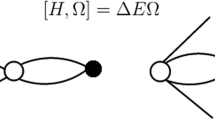Abstract
Nonradiative multiphonon transitions generated by the interaction of the electronic system with quantized normal oscillation modes are described quantum-theoretically on the basis of the static coupling scheme which is an essential, physically plausible alternative model to the adiabatic coupling scheme predominantly used in earlier papers. Putting emphasis on the mathematical correctness of the calculations we obtain a generally valid expression for nonradiative multiphonon transition rates which is based on the concept of temperature-averaged overlap factors. In the case of a single phonon energy this result is reduced to very compact expressions not given in original papers published so far. For non-vanishing phonon dispersion a simple standard formula is given which is suited for approximative numerical calculations.
Similar content being viewed by others
References
Stasiw O., Elektronen- und Ionenprozesse in Ionenkristallen. Springer, Berlin—Göttingen—Heidelberg, 1959.
Stumpf H., Quantentheorie der Ionenkristalle. Springer, Berlin—Göttingen—Heidelberg, 1961.
Bonch-Bruevich V. L., Landsberg E. G., phys. stat. sol.29 (1968), 9.
Landsberg P. T., phys. stat. sol.41 (1970), 457.
Haug A., Theoretische Festkörperphysik II, Deuticke, Wien, 1970.
Haug A., FestkörperproblemeXII (1972), 411.
Schlag E. W., Schneider E., Fischer S. F., Ann. Rev. Phys. Chem.22 (1971), 465.
Kovarskiy V. A., Chaykovskiy I. A., Sinyavskiy E. P., FTT6 (1964), 2131.
Huang K., Rhys A., Proc. Roy. Soc.A 204 (1950), 406.
Perlin Yu. E., UFN80 (1963), 553.
Helmis G., Ann. Phys. (Lpz.)19 (1956), 41.
Markham J. J., Phys. Rev. (2),103 (1956), 588
Haug A., Z. Phys.175 (1963), 166.
Howgate D. W., Phys. Rev. (2)177 (1969), 1358.
Pässler R., Diss., TH Karl-Marx-Stadt, 1972.
Meyer H. J. G., HalbleiterproblemeIII (1956), 230.
Kovarskiy V. A., FTT4 (1962), 1636.
Kovarskiy V. A., Sinyavskiy E. P., FTT4 (1962), 3202.
Kubo R., Toyozawa Y., Progr. theor. Phys.13 (1955), 160.
Fain W. M., Chanin J. I., Quantenelektronik. Teubner, Leipzig, 1969.
Stumpf H., Phys. kondens. Materie13 (1971), 101.
Krivoglaz M. A., ZhETF25 (1953), 191.
Watson G. N., A Treatise on the Theory of Bessel-Functions, Cambridge, 1962.
Lax M., J. Chem. Phys.20 (1952), 1752.
Trlifaj M., Czech. J. Phys.5 (1955), 133.
Dexter D. L., Solid State Phys.6 (1958), 353.
Krivoglaz M. A., Pekar S. I., Trudy Inst. Fiz. AN SSSR,4 (1953), 37.
Author information
Authors and Affiliations
Additional information
This paper continues the studies carried out for the thesis of the author which had been prepared under the kind guidance of Prof. Dr. M.Trlifaj, Prague, and Prof. Dr. R.Lenk, Karl-Marx-Stadt, to whom I would like to express my sincere thanks for stimulating discussions and valuable criticism.
Rights and permissions
About this article
Cite this article
Pässler, R. Description of nonradiative multiphonon transitions in the static coupling scheme. Czech J Phys 24, 322–339 (1974). https://doi.org/10.1007/BF01596354
Received:
Issue Date:
DOI: https://doi.org/10.1007/BF01596354



